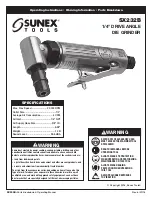
English
6
f)
Use extra caution when making a “pocket cut” into
existing walls or other blind areas.
The protruding wheel
may cut gas or water pipes, electrical wiring or objects that can
cause kickback.
Safety Warnings Specifi c for Sanding
Operations
a)
Do not use excessively oversized sanding disc paper.
Follow manufacturers recommendations, when selecting
sanding paper.
Larger sanding paper extending beyond the
sanding pad presents a laceration hazard and may cause
snagging, tearing of the disc or kickback.
Safety Warnings Specifi c for Polishing
Operations
a)
Do not allow any loose portion of the polishing bonnet
or its attachment strings to spin freely. Tuck away or
trim any loose attachment strings.
Loose and spinning
attachment strings can entangle your fingers or snag on the
workpiece.
Safety Warnings Specifi c for Wire
Brushing Operations
a)
Be aware that wire bristles are thrown by the brush even
during ordinary operation. Do not overstress the wires
by applying excessive load to the brush.
The wire bristles
can easily penetrate light clothing and/or skin.
b)
If the use of a guard is recommended for wire brushing,
do not allow any interference of the wire wheel or brush
with the guard.
Wire wheel or brush may expand in diameter
due to work and centrifugal forces.
Additional Safety Information
WARNING: ALWAYS
use safety glasses. Everyday eyeglasses are
NOT safety glasses. Also use face or dust mask if cutting operation is
dusty. ALWAYS WEAR CERTIFIED SAFETY EQUIPMENT:
• ANSI Z87.1 eye protection (CAN/CSA Z94.3),
• ANSI S12.6 (S3.19) hearing protection,
• NIOSH/OSHA/MSHA respiratory protection.
WARNING:
Some dust created by power sanding, sawing,
grinding, drilling, and other construction activities contains chemicals
known to the State of California to cause cancer, birth defects or other
reproductive harm. Some examples of these chemicals are:
• lead from lead-based paints,
• crystalline silica from bricks and cement and other masonry
products, and
• arsenic and chromium from chemically-treated lumber.
Your risk from these exposures varies, depending on how often you
do this type of work. To reduce your exposure to these chemicals:
work in a well ventilated area, and work with approved safety
equipment, such as those dust masks that are specially designed to
filter out microscopic particles.
•
Avoid prolonged contact with dust from power sanding,
sawing, grinding, drilling, and other construction activities.
Wear protective clothing and wash exposed areas with
soap and water.
Allowing dust to get into your mouth, eyes, or
lay on the skin may promote absorption of harmful chemicals.
WARNING:
Use of this tool can generate and/or disperse dust,
which may cause serious and permanent respiratory or other injury.
Always use NIOSH/OSHA approved respiratory protection appropriate
for the dust exposure. Direct particles away from face and body.









































